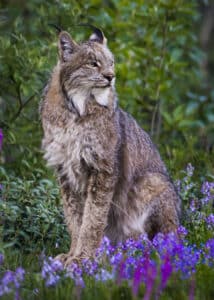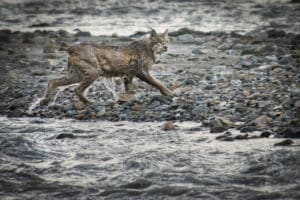
The lynx (Felis lynx) is a medium-sized cat found in mature forests throughout mainland Alaska except on the Yukon-Kuskokwim Delta and the southern part of the Alaska Peninsula. They are a holarctic species found in the northern forests from North America, across Asia and Scandinavia to Spain, Portugal, Poland, and the Balkan Peninsula. A similar species in the “Lower 48” is the bobcat (Felis Rufus) which is more tannish and has a longer tail. The legs of a lynx appear long and thick making their bodies appear disproportionately small. The great rounded feet serve well as snowshoes, and the sharp, recurved and retractable claws make them adept climbers. The tail is short, about 4 inches, and tipped with black. The ears are pointed, black-backed, and tipped with long tassels of black hairs. The tail will twitch with signals and emotions and the ears twitch as the cat sorts out the sounds around them. The great yellow eyes have black pupils as verticle slits.
The lynx, like all cats, can relax so completely they seem an empty bag of skin. Their summer fur is tawny in color but with the shortening of daylight in the fall, lynx hormones transform the signal into the growth of new fur which is longer and thicker and grayish in color. At this same time, stiff hairs on the feet grow longer making a larger bearing surface for walking on snow. Because of the extremely effective insulation of their fur they don’t need to put on the extra layers of body fat for winter preparation that many northern mammals do. The males are larger than the females and can weigh up to 30 pounds and stand 24 to 28 inches at the shoulder.
Lynx are solitary, silent hunters and are primarily nocturnal. They travel in pairs only during the mating season (March and April). The female’s gestations period is approximately 9 weeks and the litters may produce one to five kittens. The females are monoestrous and possess 4 teats. With increasing availability of prey (snowshoe hare), females will breed their first year and have larger litters with higher survival rates for the kittens. In leaner years, a young female will not breed until the second year and will have smaller litters. The kittens are altricial, born with their eyes closed, and covered with a fluffy natal coat for their first eight weeks. The kittens molt into the adult coat at the age of 8 to 10 months. They will remain with their mother through the first winter as she teaches the needed hunting skills through elaborate games of stalk and pounce.

Although lynx prefers the climax boreal forest with dense undercover thickets, during times of starvation they will venture onto the tundra and beyond treeline in search of food such as mice, birds, squirrels and even Dall sheep and caribou in extreme situations. Lynx can actually swim quite well but they eat very little fish, except for the occasional salmon. They remain active all winter except during the severest weather when they simply bed down in the snow and take advantage of the insulation. They have a poor sense of smell, perhaps because of the cold taiga they inhabit. At deeply cold temperatures little scent is transmitted so, the adaptive necessity for a highly developed sense of smell did not prevail. With the lack of snowshoe hare abundance the past several years, the woods and willow patches were a quiet stage as the lynx, in turn, decreased in number and resorted to other prey. As the hare populations head toward an increase, the lynx will inevitably benefit.



